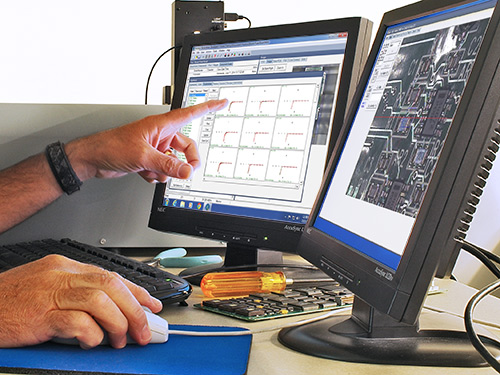
3 MIN. READ
Testing printed circuit boards (PCBs) is largely automated. However, the testing process still requires expertise to collect, sort and cleanse data for statistical analysis. Moreover, some test procedures are still better conducted manually. As a result, even PCB manufacturers that use automated PCB testing still need test engineers and technicians to support them. Here is an overview of what these experts do and how to utilize them.
The role of test engineers in PCB testing
Test engineers play a critical role in PCB testing because they are the experts who design the tests to determine whether PCBs meet the design specifications. Test engineers know an efficient testing program will acknowledge the reality that it is impossible to test every component and circuit when operating at production levels. Thus, it is up to the test engineers to determine how to test PCBs to ensure that they are functional under normal operating conditions without excessively slowing production.
These engineers must understand the strengths and weaknesses of each type of test and what those tests reveal about the PCB. By designing a test strategy that reveals exactly what performance characteristics of the PCB are necessary to its functionality, the test engineers can help reduce warranty repairs and replacements, thereby improving customer satisfaction.
The role of technicians in PCB testing
Technicians usually have a different type of education than engineers. While engineers are mostly educated in theory, technicians are usually educated in the hands-on practice of testing PCBs. Technicians are just as critical to a testing program as engineers, but they are usually paid less because qualified technicians are easier to find than qualified engineers.
Technicians implement the testing program. Junior technicians operate the testing equipment, conduct manual tests and gather testing data. Senior technicians take the testing data and make sense of it.
Specifically, analysis of testing data takes two forms:
- Identify defective products: Some testing data is used to identify specific products that are defective and cannot be allowed to leave the production facility. These products can be pulled out of the production line when testing reveals they are defective.
- Identify defective processes and materials: Statistical analysis of the testing data can reveal problems with an entire production line. For example, a batch of bad capacitors or solder issues can cause consistently defective PCBs that can be detected by the testing program.
Allocating your resources for PCB testing
Assigning tasks proportional to the pay and appropriate for the education of your testing staff will produce a more efficient and better functioning testing program. Assigning an engineer to implement the testing program is not only a waste of money (since the engineer will be paid much more than a technician) but it could also make your testing much less efficient since engineers know theory but may not be qualified to operate testing equipment.
Similarly, assigning technicians to design a testing program might leave gaps that will allow defective products to escape detection. By balancing their roles with their qualifications and salaries, you can optimize your PCB testing program.
Huntron Inc. provides testing equipment to automate PCB testing. To learn how Huntron can streamline your PCB testing program, contact us to schedule a demo.
Meta Title:
Optimizing your engineers for PCB testing
Meta Description:
Understanding the purpose and capabilities of a PCB testing program will help you to allocate your human resources, such as engineers and technicians, to optimize your PCB testing.
Meta Keywords:
PCB testing

